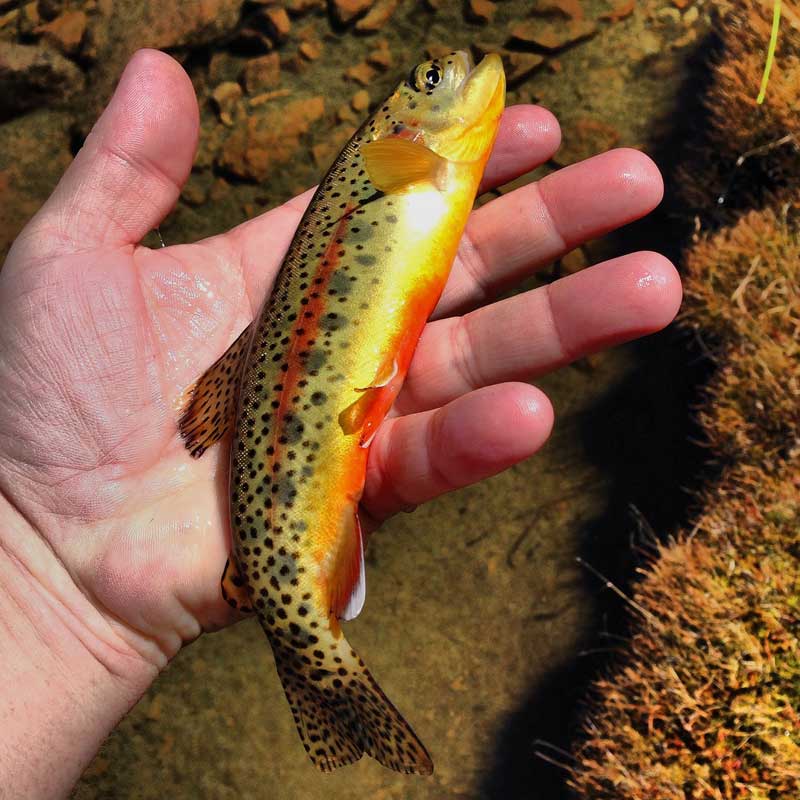
This story is the first in a two-part series (read part two here) offering a brief overview of stream ecology and monitoring. Though initially written for a fly-fishing audience in southeastern Pennsylvania, the information should be of interest to anyone seeking to be a guardian of their local streams.
Streams Are Complex Living Systems
Streams and the valleys they drain are complex environments with many exceptions to standard rules. This complexity is what makes regulating, restoring, and protecting these aquatic systems such a complicated process. And it is why we need motivated people who can dedicate time and energy to understanding and defending their local watersheds.
Contrary to what many people believe, streams and rivers are not simply channels in the earth that carry water. They are living systems defined by the surrounding watershed’s geology, topography, vegetation, and climate and are often highly influenced by what humans are doing nearby.
The Water
River water is a diverse mixture of dissolved and suspended organic and inorganic material that reflects watershed conditions as a whole. The local geology and soil impart characteristics to the water and its bed, banks, and channels that are unique to the local landscape. The underlying geology and soil, along with plant material from the surrounding landscape, define the substrate in a stream, which is foundational to a stream’s biological community.
The Substrate and Its Biofilm
The rocks, sand, silt, sticks, logs, and leaves making up this substrate are colonized by biofilm – thousands and possibly millions of species of bacteria, algae, and fungi, many yet to be classified – that set the biological foundation of the stream ecosystem.
The biofilm community breaks down organic material like leaves and aquatic vegetation, making them available as food for macroinvertebrates (e.g., aquatic insects, crustaceans, and worms) and some herbivorous and omnivorous fish species. Natural chemical conditions, toxic inputs, nutrients (e.g., nitrogen and phosphorus), and hydrology (water levels, flow velocity, flooding) all impact and define this microbial foundation within a stream.
The Macroinvertebrates
As defined by both the natural setting and human influences, a stream and watershed’s overall character determines the types of habitat, shelter, feeding, and reproductive opportunities available to stream biota. Animals with diverse life histories and feeding habits take shelter, build homes, and harvest food in nearly every part of the stream. It is not uncommon for macroinvertebrate densities to range up to several thousand individuals per square foot.
Some types of caddisfly larvae collect food by spinning nets that filter algae and other organic material from flowing water that they then gather and eat. Other filterers such as Isonychia mayflies collect food from the water with long hairs on their forelegs. Crane fly and some stonefly larvae shred and consume leaves from streamside trees and shrubs after these plant materials have been softened and made more palatable by stream microbes. Other species like hellgrammites, some types of stoneflies, and dragonflies are predators, feeding on other invertebrates.
Many macroinvertebrate species take shelter and do their feeding on the stream bottom under and between rocks, where they scrape the biofilm off these substrates using specialized mouthparts (e.g., Heptageniid mayflies). Other macroinvertebrates like the Ephemerid mayflies, many midge species, and worms prefer to burrow into finer sediment where they filter and collect organic particles. Other macroinvertebrates like Baetid mayfly larvae, scuds, cress bugs, and sowbugs can often be found living in and feeding on aquatic vegetation and being preyed upon by species like damselflies.
The Vertebrates
The fish and other vertebrate species found in a stream also have specific requirements for shelter and conditions for feeding and growth. The surrounding landscape and underlying geology are key to providing water cold enough to support trout physiological needs for high oxygen levels (colder water holds more oxygen). Trout living in streams and rivers take shelter from strong currents behind boulders, in deep pools, under banks, and amongst tree roots and stumps. Both live trees rooted in stream banks and dead trees that have fallen into the stream are beneficial to trout, providing shade, structure, and protection. But trout are resourceful, and as long as food is available and water temperature and chemical conditions are right, they can use many different habitats.
In fast-flowing streams, trout will feed in areas where streamflow naturally funnels food past habitat refuges. In slower river systems and lakes, trout will more frequently seek out food. Large trout are known to patrol the downstream ends of pools at night, hunting smaller fish, crayfish, amphibians, and even birds or mice that fall into the water. In many of the slow-flowing limestone springs of central and southern Pennsylvania, trout will rip and tear at aquatic vegetation, dislodging and eating scuds, cress bugs, and other macroinvertebrates.
The physical conditions of a stream are also critical with regard to spawning grounds for fish. Spawning trout need clean porous gravel (i.e., not clogged with silt and sand) with swift flow. Other fish species such as bass or sunfish may need slower silty and sandy conditions, more characteristic of larger warm water rivers and smaller streams degraded from human activity.
Stream Health Indicators
In fly fishing, the angler often focuses on the insects, crustaceans, and smaller fish that trout and other sportfish eat. Trout are relatively sensitive to pollution, and so are many of the macroinvertebrate and vertebrate species that the fly angler imitates. Plenty of them are much more sensitive than trout. In freshwater ecology, we use these types of pollution-sensitive animals as indicators of aquatic health. If they are found in a stream, that stream is considered healthy; if they are absent, the stream is likely degraded.
What are these pollution-intolerant species of macroinvertebrates and small fish? As one might expect, they are the bugs and fish that trout anglers imitate with their lures (i.e., “flies”).
Mayflies (Ephemeroptera), stoneflies (Plecoptera), and caddisflies (Trichoptera) are the three main groups of macroinvertebrates that aquatic ecologists use to evaluate stream health. Generally, the greater the abundance and diversity of these “EPT” taxa, the greater the stream health.
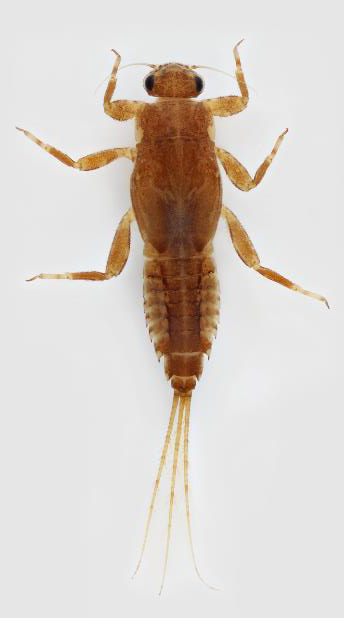
Mayfly larva (Order: Ephemeroptera; Genus: Ephemerella) 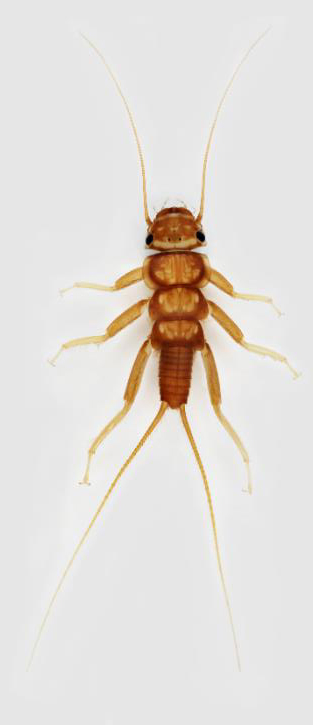
Stonefly larva (Order: Plecoptera; Genus: Acroneuria) 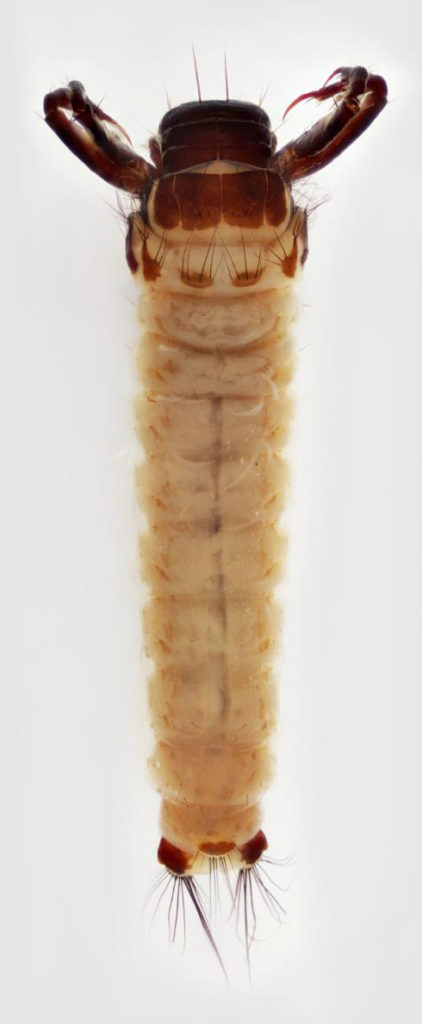
Caddisfly larva (Order: Trichoptera; Genus: Brachycentrus)
Brook trout, brown trout, and rainbow trout, plus lots of non-sport fish like sculpins, darters, certain types of suckers and dace, and many others, are the fish species ecologists use as indicators of stream health.
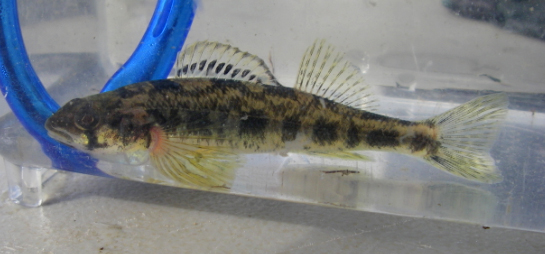
Shield darter (Percina peltata) 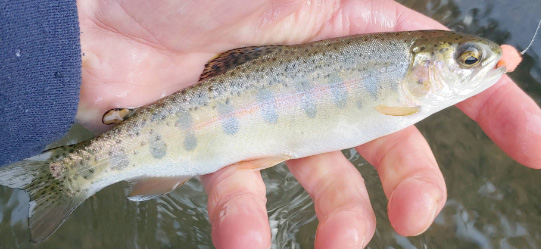
Rainbow trout (Oncorhynchus mykiss) 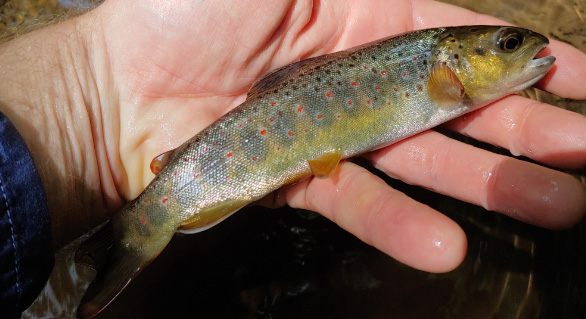
Brown trout (Salmo trutta) 
Brook trout (Salvelinus fontinalis) 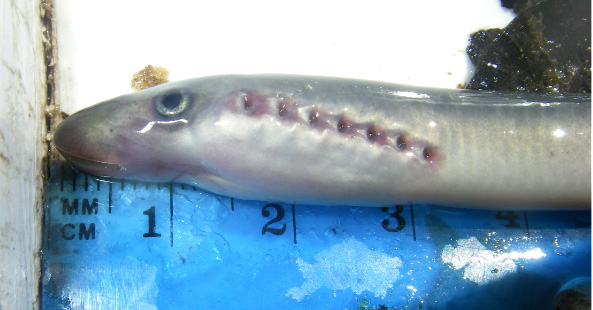
American brook lamprey (Lethenteron appendix)
To think more deeply about the complexities of stream health and ecology in relation to trout, keep in mind that brown trout and rainbow trout are resilient to some types of pollution and indeed can be found in many streams that are not of the highest quality, especially if water temperature remains suitable (i.e., below 70° F). Similarly, there are types of both caddisflies (e.g., Hydropsychidae net-spinners) and mayflies (e.g., Baetidae swimmers) that are somewhat resilient to disturbance. It is extremely rare, however, to find stoneflies anywhere but the healthiest watersheds.
Stream Stressors
Water Temperature
Water temperature is a critical component for trout, especially brook trout, the only native non-migratory trout species in eastern North America. These sensitive salmonids need colder water than brown trout (native to Europe) and rainbow trout (native to the Pacific coast of North America). Sadly, in southeastern Pennsylvania, many streams can no longer hold trout because they get too warm in the summer. Even if many of these streams were cold enough, they would likely still have too many acute and chronic stressors to support trout, especially brook trout. As mentioned, many EPT macroinvertebrates are as pollution sensitive, if not more so, than trout, so many of these animals are no longer present either.
Pollutants
Pesticides, fertilizer, road deicers, heavy metals, industrial and household waste, petroleum products, and many other contaminants form a “chemical cocktail” whose cumulative toxicity to stream biota is not yet fully understood. Physical, hydrological, and biological stressors such as silt and sediment, habitat and substrate-altering storm flows, and non-native species of plants and animals can all be equally detrimental to stream health.
What do all of these stressors have in common? Their source is human activity. Roads and parking lots, residential developments, wastewater treatment plants, agricultural areas, commercial zones, industrial facilities, abandoned and active mines and quarries, oil and gas wells, and many other types of human activity all produce a wide variety of potentially harmful materials that end up in streams and rivers.
These pollutants generally make their way to nearby waterways via runoff or groundwater (i.e., non-point source pollution) or piped discharges (i.e., point source pollution). When rain falls or snow melts, the water flows across the land and washes pollutants into the nearest stream, storm drain, culvert, or ditch, ultimately ending up in our largest rivers like the Delaware or Susquehanna. Some of this runoff may be absorbed by the ground where soil microbes may degrade some pollutants, but many others will not, and instead will later enter the nearest stream via groundwater seeps and springs.
Commercial facilities, industrial sites, and wastewater treatment plants discharge a wide variety of substances via piped effluent that, even if they are within the range of permitted levels, can still cause significant loss of ecological integrity of receiving water bodies. In severe cases, illicit, unpermitted, or accidental point-source discharges, spills, and other accidents can cause massive die-offs of fish and many other animals, plants, and microbes.
Invasive Species
Human activity is also the cause of most biological stressors, like the introduction of non-native species. Some non-native species were introduced purposefully, for example, for population control of nuisance species, sportfish stocking, or as ornamental plants. Others were introduced accidentally by boat, vehicle, and foot travel, or by the release or escape of exotic pet store plants and animals.
A wide array of invasive plant, algal, fungal, invertebrate, and vertebrate species now compete with and influence southeastern Pennsylvania’s indigenous biota and cause complex cascading effects on the established biological communities. Some of the more prominent invasive aquatic animals include flathead catfish, snakeheads, rusty and virile crayfish, zebra mussels, and Asian clams, but there are many others. Invasive terrestrial plants like the common reed (Phragmites), Japanese stiltgrass, Japanese knotweed, and multiflora rose displace native species, causing riparian forest health degradation. Furthermore, some of these invasive plants, like multiflora rose, have lower nutritional value to aquatic macroinvertebrate shredder species.
The Result: Impaired Streams
There are plenty of animals that can live in streams degraded by abiotic and biotic stressors; however, trout and especially EPT macroinvertebrate species are not usually among these. True, there are limestone streams that hang on, buffering pollution with cold alkaline spring water and continuing to harbor wild reproducing trout populations and a few of the more resilient EPT species.
Yes, some relatively undeveloped watersheds in southeastern Pennsylvania with well-established riparian forest buffers stay cold enough to support reproducing populations of brown and rainbow trout. And yes, there are still even a few tiny isolated headwater streams tucked away in some of the preserved forested land in our region that still hold brook trout.
But today’s landscape in southeastern Pennsylvania and the streams that drain that landscape have been battered by human activity for hundreds of years. Native hemlock forests that covered the state before European arrival were cut down long ago, and the invasive woolly adelgid threatens to eliminate the remaining hemlocks. Historic dams across the region prevent fish migration and spawning and disrupt natural sediment movement and hydrology. Roads, parking lots, developments, agriculture, and industrial facilities now cover much of the southeastern Pennsylvania landscape.
Many streams and rivers have been moved, straightened, and piped and now serve as only crude conveyances of stormwater. Many more have been pressured incessantly by expanding housing and commercial developments that were often built far too close to streams and did not have adequate infrastructure to allow stormwater to infiltrate the soil. Increasingly intensive and chemical-reliant agriculture introduces sediment, nutrients, and pesticides to streams and rivers across the region.
Although there is growing usage of more environmentally friendly stormwater best management practices and more sustainable and conservative agricultural practices, most watersheds are no longer able to support trout and many sensitive (and increasingly rare) species of aquatic insects, crustaceans, and bivalves, or a wide variety of amphibians, reptiles, and mammals. As a result, many of our streams and rivers are now impaired according to state, county, and federal environmental agencies’ standardized regulatory assessments.
Read part two of this story, which will discuss stream impairment and monitoring and how interested individuals can take steps to become stream guardians and advocates.
About the author: Dave Bressler is the citizen science project coordinator at Stroud Water Research Center, which seeks to advance knowledge and stewardship of freshwater systems through global research, education, and watershed restoration. Dave grew up in central Pennsylvania and started fly fishing in his early teens on the Little Juniata, Spruce Creek, and Spring Creek. Since then he has tied flies and fished them on streams and rivers in most parts of the country that have trout.
We welcome Manage My Watershed members to share their thoughts using the comment form below. Not a member? Register or show your appreciation with the “Like” button. And if you have a watershed story to tell, please share it with our community!

Carol Armstrong
Thank you David for describing the linkages of our streams to our natural world through the lives of aquatic wildlife, and how we are dependent on their ‘activities of daily living’ to have a stream that is a “living system”. The examples provide beautiful imagery that inspires.